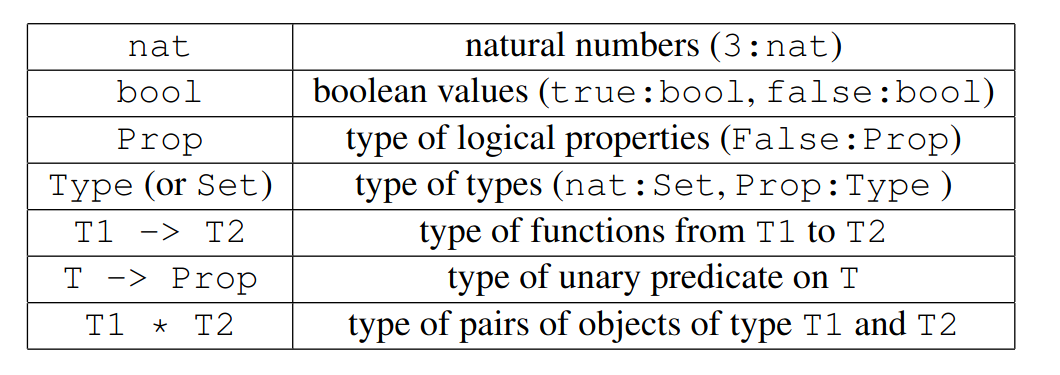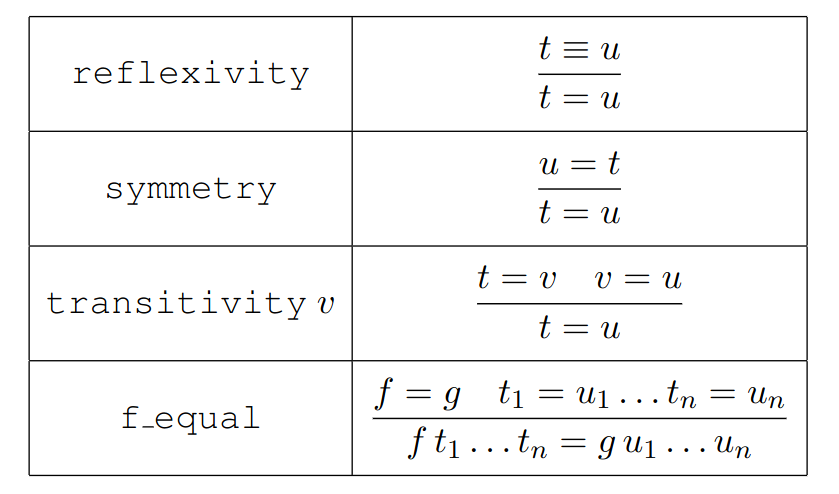Course6: Equality Proofs and
Proofs by Induction in Coq
Summary of elementary tactics



- assumption if the current goal is exactly one of the hypothesis (cf. the axiom rule in logic).
- For all primitive connectors (quantification ∀,
implication →):
- introduction via intro (or one of its variants intros,
- elimination via apply H (where H is the name of
- The other connectors (which are actually inductive definitions)
may ideally be introduced by constructor and eliminated by
destruct H.
But the introduction frequently requires more ad-hoc tactics:
- split for a conjunction ∧ (written
/\) - left and right for a disjunction ∨ (written
\/) - ∃ ... (written
exists) for a quantification ∃
- No introduction tactic for False !
- For True (seldom used in Coq), the introduction can
- split for a conjunction ∧ (written
- The simpl tactic performs a conversion on the goal.
- In Coq, a definition d could be replaced by its body thanks to the tactic unfold d.
- Some abbreviations:
- A negation ¬A (written
~A) is just a shortcut for A→False.
- An equivalence A↔B (written
A<->B) is just a shortcut for (A→B)/\(B→A),
- A negation ¬A (written
- Some automatic tactics : trivial, easy, auto, eauto, intuition, firstorder. See the Coq documentation for more details.

Today's program
- reflexivity
- symmetry
- transitivity ... (where you need to give the intermediate
- rewrite ... (give the equality name or lemma to use as a
- rewrite <- ... (right-to-left rewriting)
- induction ... (to do inductive reasoning, to be investigated in the next lectures).
Managing the interactive proof progresses
- Undo: goes back one tactic
- Restart: restart the proof from the original goal
- Abort: Aborts the current proof.
- Admitted: gives up the current proof and declares the initial goal as an axiom.
- Focusing using bullets or i: { tac }
- Applying a tactic to the i-th goal: i:tac, ...
- Modifying the goal list: all: swap i j
- Getting information:
- Show display the current goals;
- Show Proof displays the current proof term (with holes for open goals).
Composing tactics

- tac ;[tac1 |. . .|tacn]: applies tac to the goal which generates n subgoals
and taci is applied to the i-th subgoal.
- idtac: always succeed, leaving the goal unchanged.
- fail: always fail (useful to implement a tactic saying:
"I solve the goal immediatly or I fail" with tac; fail.
Indeed, if tac fails, it fails, if tac succeeds producing at least one subgoal,
it fails and if tac suceeds producing no subgoal, it succeeds.
- try: it behaves like tac || idtac. It is often useful to do tac ; try tac'. Another example is tac; try (tac'; fail). this tries applying tac' to the subgoals generated by tac but only to those which are completely solved by tac', leaving the other ones unchanged.
A tiny bit of automation: auto and trivial
Searching for Lemmas
About nat.
About O.
Search 0.
Search "_comm".
It is possibl to search by describing a pattern
of what you are looking for:
Require Import ZArith.
SearchPattern (_ + _ ≤ _)%Z.
SearchPattern (_ × _ ≤ _ × _)%Z.
also non linear patterns:
SearchPattern (?X1 × _ ≤ ?X1 × _)%Z.
SearchPattern (?X1 × _ ≤ ?X1 × _).
Searching only for equalities:
SearchRewrite (1 × _)%Z.
SearchPattern (_ = 1 × _ )%Z.
Print eq.
Syntactic equality : only x is equal to x
Inductive eq (A : Type) (x : A) : A -> Prop := eq_refl : eq A x x.constructor is the reflexivity rule. tactic "reflexivity"
Lemma compute_equal : 2+2 = 4.
Proof.
simpl.
reflexivity.
Qed.
Check eq_ind.
The Leibniz principle, or the rewrite principle :
match on a equality is a form of rewrite
the rewrite tactic proceed by a match on the equality
eq_ind
: forall (A : Type) (x : A) (P : A -> Prop),
P x -> forall y : A, x = y -> P y
Print eq_ind.
Lemma eq_sym A (x y : A) : x = y → y = x.
Proof.
intro H. Show Proof.
destruct H. Show Proof. reflexivity.
Qed.
Print eq_sym.
rewriting equalities
Open Scope Z_scope.
Theorem Zmult_distr_1: ∀ n x: Z, n × x + x = (n+1)* x.
Proof.
intros n x.
Check Zmult_plus_distr_l.
rewrite Zmult_plus_distr_l.
rewrite Zmult_1_l.
reflexivity.
Qed.
It is possible to rewrite in an hypothesis with
rewrite H in H'.
When there are multiple occurrences of a terme
and one wants to rewrite just one, the pattern tactic comes in handy:
pattern t at i j k.
The pattern tactic:
Theorem regroup : ∀ x: Z, x+x+x+x+x = 5 × x.
Proof.
pose Zmult_1_l as H1.
pose Zmult_distr_1 as H2.
intro x.
(* rewrite <- H1. *)
pattern x at 1.
rewrite <- H1.
repeat rewrite H2.
reflexivity.
(* trivial. *)
(* auto.*)
Qed.
Require Import Arith.
Open Scope nat_scope.
Section Condrewrite.
Hypothesis le_lt_S_eq : ∀ n p: nat,
n ≤ p → p < S n → n=p.
Lemma cond_rewrite_example: ∀ n: nat,
8 < n+6 → 3+n < 6 → n×n = n+n.
Proof.
intros n H H0.
pose (le_lt_S_eq 2 n) as H2.
rewrite <- H2.
reflexivity.
(* simpl; auto. *)
apply Nat.add_le_mono_l with (p := 6).
rewrite Nat.add_comm in H; simpl; auto with arith.
apply Nat.add_le_mono_l with (p :=3); auto with arith.
Qed.
End Condrewrite.
Print nat.
Check nat_ind.
Print nat_ind. (* fixpoint + match *)
Lemma test_induction1 : ∀ n:nat, n=n.
intro n.
elim n.
- reflexivity.
- intros n0 Hrec.
reflexivity.
Qed.
Lemma test_induction2 : ∀ n:nat, n=n.
intro n.
destruct n.
- reflexivity.
- reflexivity.
Qed.
Lemma test_induction3 : ∀ n:nat, n=n.
induction n.
- reflexivity.
- reflexivity.
Show Proof.
Abort.
Lemma test_induction4 : ∀ H: Prop, H → ∀ n:nat, n=n.
induction n.
- reflexivity.
- reflexivity.
Show Proof.
Abort.
Print "+".
2+2 = Nat.add (S (S 0)) 2.
= match S (S 0) with
| 0 => m
| S p => S (add p 2)
(* unfold rule for fixpoint : a fixpoint applied to a constructor can
unfold once *)
= S (add (S 0) 2)
= ...
= 4
Compute 2+2.
Require Import Arith.
Check Nat.add_succ_l.
Lemma non_compute_proof : 2+2 = 4.
Proof.
rewrite Nat.add_succ_l.
rewrite Nat.add_succ_l.
rewrite Nat.add_0_l.
reflexivity.
Qed.
Print non_compute_proof.
Print Nat.add_succ_l.
Lemma compute_proof : 2+2 = 4.
(* in coq, most of the time we're modulo computation :
2+2 just the same as 4 *)
simpl. (* force a computation *)
reflexivity.
Set Printing Implicit.
Show Proof.
Check (@eq_refl nat 4).
(* 2+2=4 and 4=4 are the *same* statement (modulo computation) :
(what we call *convertible* )
they can be proved by the *same* proof term *)
Qed.
Lemma compute_proof' : 2+2 = 4.
reflexivity.
Qed.
Definition compute_proof'' : 2+2 = 4 := eq_refl.
(* or more precisely @eq_refl nat 4 *)
Require Import Arith.
Check Nat.add_succ_l.
Lemma non_compute_proof : 2+2 = 4.
Proof.
rewrite Nat.add_succ_l.
rewrite Nat.add_succ_l.
rewrite Nat.add_0_l.
reflexivity.
Qed.
Print non_compute_proof.
Print Nat.add_succ_l.
Lemma compute_proof : 2+2 = 4.
(* in coq, most of the time we're modulo computation :
2+2 just the same as 4 *)
simpl. (* force a computation *)
reflexivity.
Set Printing Implicit.
Show Proof.
Check (@eq_refl nat 4).
(* 2+2=4 and 4=4 are the *same* statement (modulo computation) :
(what we call *convertible* )
they can be proved by the *same* proof term *)
Qed.
Lemma compute_proof' : 2+2 = 4.
reflexivity.
Qed.
Definition compute_proof'' : 2+2 = 4 := eq_refl.
(* or more precisely @eq_refl nat 4 *)
This page has been generated by coqdoc
